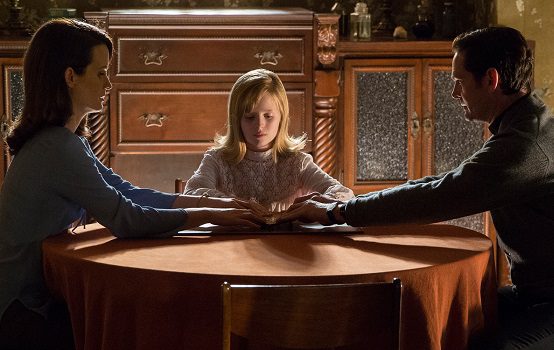Eve Tushnet is a TAC contributing editor, blogs at Patheos.com, and is the author of Gay and Catholic: Accepting My Sexuality, Finding Community, Living My Faith, as well as the author of the newly released novel Amends, a satire set during the filming of a reality show about alcohol rehab.
Spirits, What Have You to Say?

I watched Ouija: Origin of Evil last night, and it was a pretty good flick. But I’m still a little confused about the Ouija board’s motivation.
I watched the movie because of this article about Blumhouse, a horror-centered production company making “nuanced dramas about families, class, and morality — but instead of divorce or dysfunction, they’re typically dealing with possessed children, haunted houses, and manhunting mobs.”
Unlike the original Ouija, to which it is a prequel, Origin of Evil is a period piece set in 1967, exploring the close but tense relationships among a widowed mother who works as a “medium” and her two daughters. It’s also totally a movie about a haunted Ouija board.
I’ve seen three other Blumhouse joints: the forgettable-to-execrable The Gallows, the really satisfying “home invasion with a deaf girl” Hush, and Creep. Creep best fits the pitch in that Ringer article. It’s a muscular, disturbing film about a man haunted and warped by loneliness, by a longing for friendship; it’s an exploration of weakness and strength, and the blurred line between kindness, condescension, and codependency. It’s also a very tense and scary suspense flick, with stalking-the-prey scenes and shock cuts. But Creep’s last sequences show a willingness to sink into horror cliché.
Origin of Evil, written and directed by Mike Flanagan, makes the same misguided turn away from its previous intelligence—only the turn happens much earlier, at the very start of the climactic action.
Up until then it’s a well-balanced film, mixing family drama, exploration of universal human longings, and fun spookfest. We begin with Alice (Elizabeth Reaser) leading a séance, as blown-out candles answer the questions everybody asks: What is it like after death? Are you in pain? Can you forgive me?
Alice is faking it, obviously—her kids are part of her act, one hiding in the cupboard and the other looming ghostishly behind a curtain. She has developed a moral justification for deceiving the bereaved: “It’s our job to comfort them,” she tells her older daughter, Lena (Annalise Basso), “not judge them.” She says this right after totally (and accurately) judging one of their clients, a woman trying to scam her own father out of his money—the scammer exposing a scam!—but the irony is presented gently. This movie respects its characters’ convictions.
That extends to the other adult in the mix. Father Tom Hogan (Henry Thomas) entered the priesthood after he was widowed, so he and the mom have something in common. They share a disingenuous quasi-date … and then decide they could’ve had something together “in another life.” And so the priest toasts, “To another life, then!” The moment is spooky, recalling the movie’s themes of anguished survivors and unhappy ghosts, but it’s built on acceptance of his vocation and his duties.
The ’60s setting isn’t just about the cute clothes all the women wear. It’s mined for symbolism: the moon shot is a recurring theme, another exploration into the extreme edge of human knowledge. (I was reminded of that Soviet poster that claimed Yuri Gagarin found no God in the heavens.) It makes some sly cultural criticism possible: the television slowly takes on a sinister aspect as the possessed younger daughter, Doris, zones out in front of it, her eyes going completely white.
And the movie captures with surprising accuracy an unsteady moment in American Catholicism. The priest commands genuine respect from everybody in this movie—even though they don’t particularly feel the need to obey him. He also isn’t particularly useful against the demons, or right about their nature.
And this is where the movie falls apart. Origin of Evil is perfectly set up to go full Catholic—they show us real demons!—but instead its vision of the afterlife is a bizarre mishmosh of concepts and theologies. There are demons, but they’re also … Nazi ghosts? Or no, they’re the evil ghosts of Nazis’ victims? And there are also good ghosts? Why does being tortured to death make you evil, but being killed by a drunk driver keep you good?
Why did we need evil Nazi-victim demon ghosts in this movie about a grieving family and their questions about God’s providence?
Origin of Evil reminded me not of other Blumhouse films, but of 2014’s Taking of Deborah Logan. That’s also a possession film with an unusual trio of compelling female protagonists (a woman with Alzheimer’s, her caretaker daughter, and the documentary filmmaker who wants to tell their story). It’s also got a strong emotional core, in the parallel between the loss of personality caused by Alzheimer’s and literal demonic possession. And it also loses its focus amid conflicting explanations and extra plot twists.
A movie about the supernatural can withhold answers from the audience; it can humble our pride. (Lake Mungo, The Objective, Neither Heaven Nor Earth.) But if you answer the question “What happens to us when we die?” make sure you have something to say.
Comments